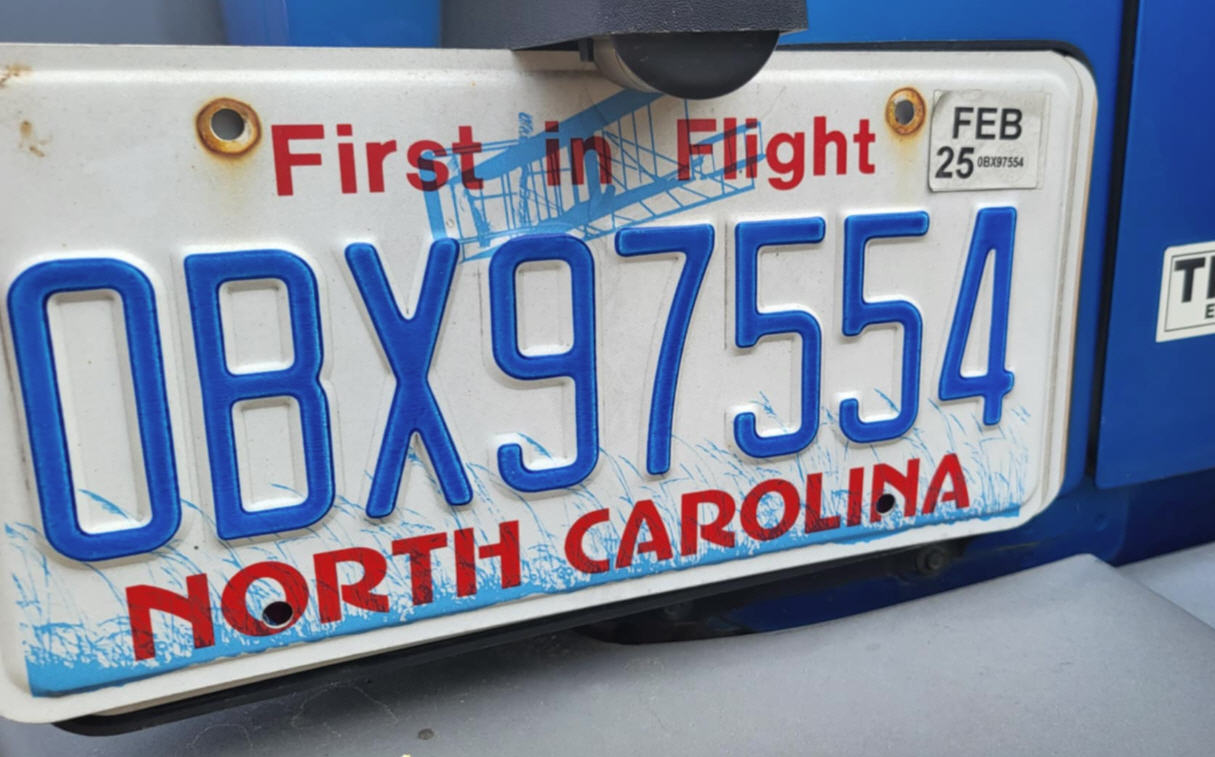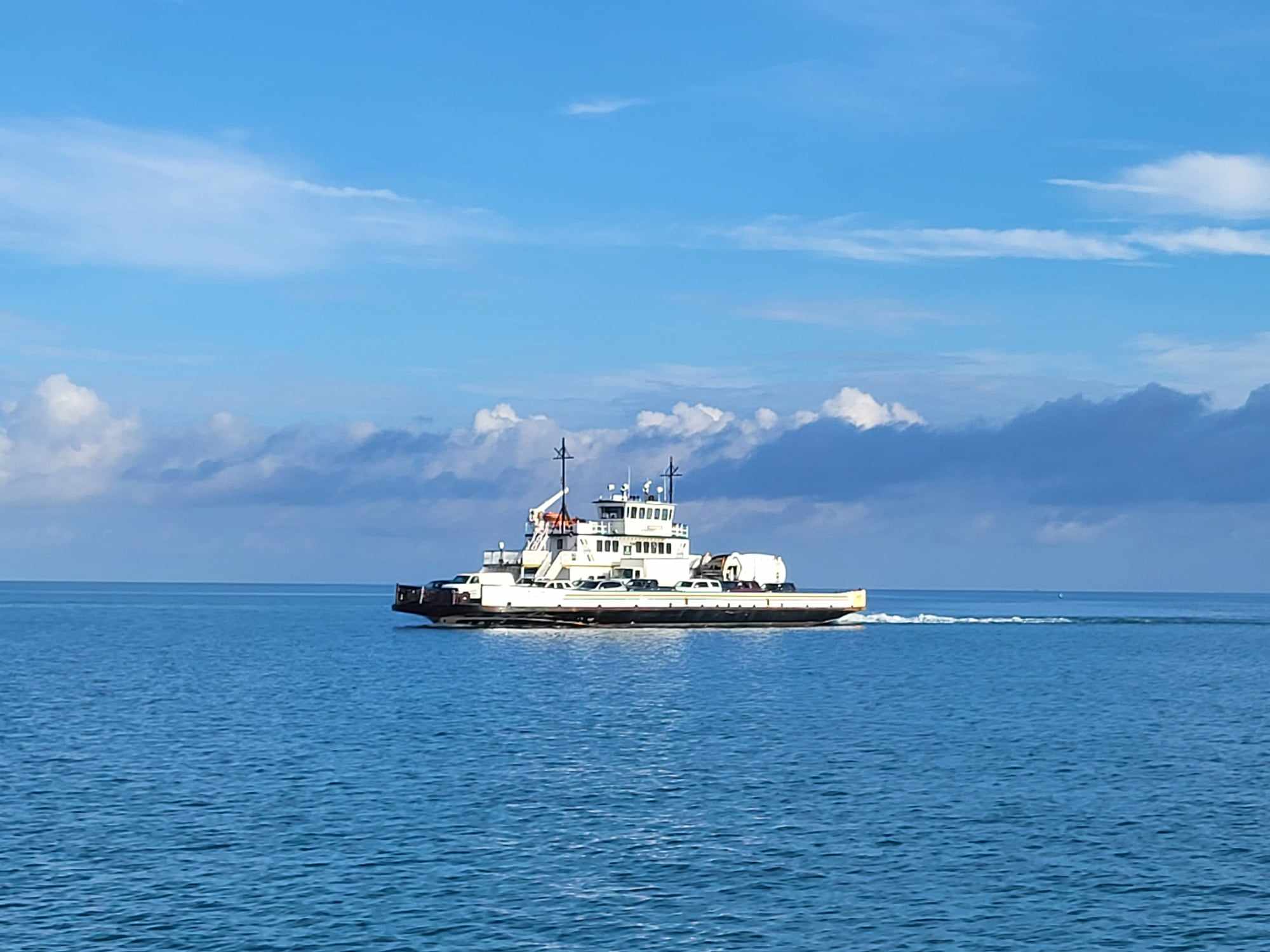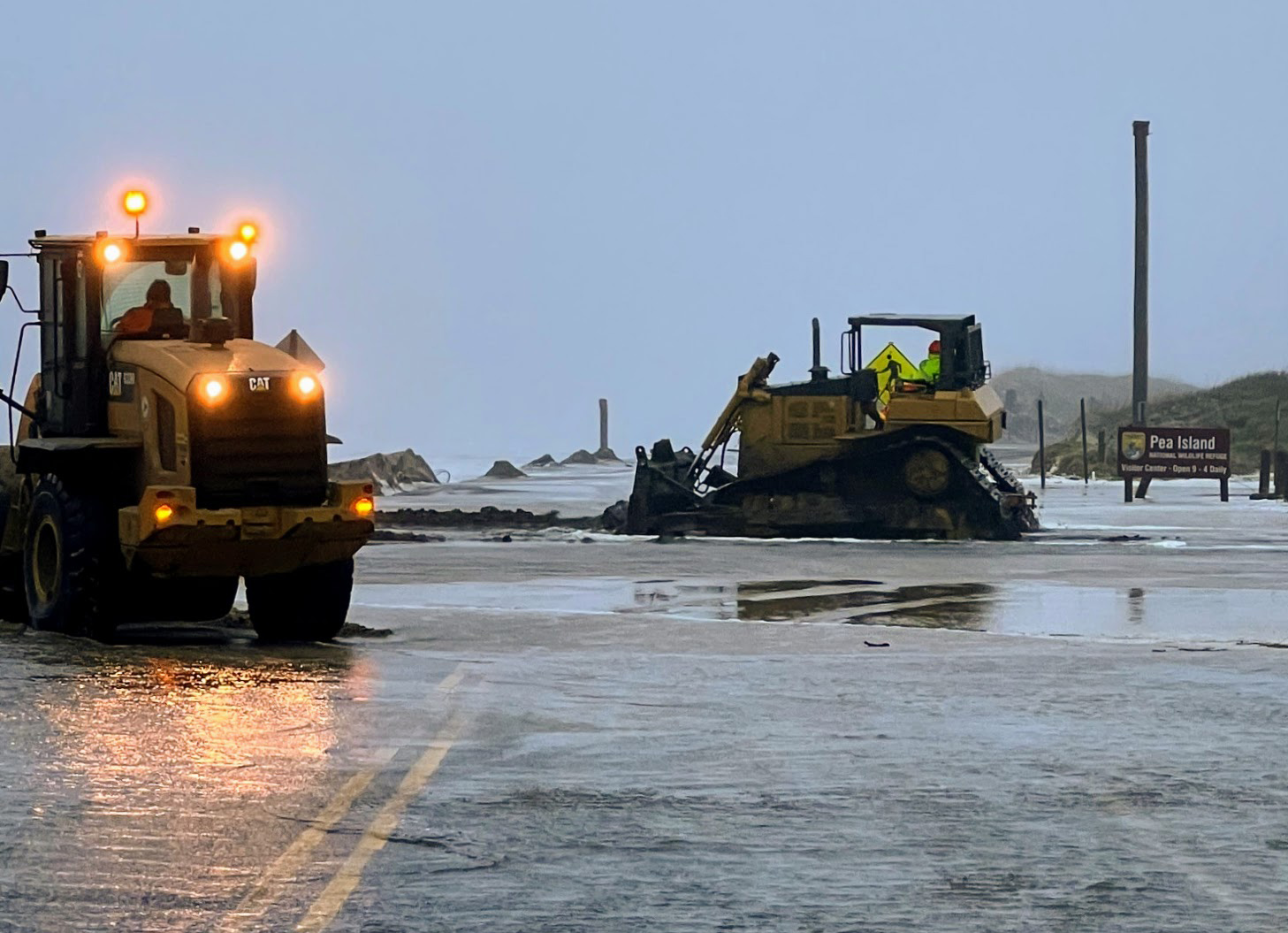The story of one Kinnakeet family and the struggle to rebuild after Hurricane Irene
The Fullers are your typical Hatteras Island family with two young children. There’s curly-haired Grace, who will turn 5 in January and is too adorable for words, and Big Jack, who will turn 2, also in January, and whose size alone, despite his sweet nature, has prompted folks to say “Boy, I hope he’s not a bully when he grows up!”
Mandy, the mom, is a marketing associate and photographer at a local real estate company, and Jamie, the dad, is an established construction worker, affiliated with a number of respected contractors on the island.
They are your typical successful local family and community members.
But these days, unfortunately, they are typical for another reason as well – they are one of the many families that are still adjusting to an altered, uprooted life after Hurricane Irene and will do so for months to come.
Their story begins with a historical one-story house in Avon village, which has always been in Jamie’s family and is an estimated 110 years old.
Jamie, whose family has deep roots on the island, purchased the home from a cousin 9 or 10 years ago, in exchange for some cash and some labor. At that time, the little, red one-story building — fondly called “The Red House” — was in need of attention. It had spent a few decades as a residence, and then as a store during the 1940s and 1950s, and then a residence again. By the time Jamie claimed it, the house hadn’t been used in a long time and was in desperate need of some restoration.
And restore he did.
Jamie and his wife spent the next decade tearing out floors and walls to the bare wood and timbers beneath, adding rooms, adding walls, closing up the “trap door” on the floor that was installed decades ago as an old-school means to let flood waters out, and basically creating a home that could fit their growing family.
Now, the Fullers were smart and seasoned locals. They knew that the water in Avon had risen before and was likely to rise again — after all, there was originally a trap door for floodwater. So while renovating, they made conscious decisions to make the home as flood-proof as possible.
The insulation they used was flood resistant, a sort of silver-bubble-wrap that lay under the Pergo floors and behind the walls, and, instead of drywall, they opted for wainscoting and wooden beadboard that could hopefully be salvaged in the wake of a flood and that climbed a good three feet up the walls.
Keep in mind that the house and the renovations were paid for out of pocket from the get-go, so the Fullers were not required to have insurance. And being on a tight budget, they were unable to shell out more money for the staggering high cost of flood insurance on a historical one-story home, sitting only a foot and a half off the ground.
With hard work and a few years of persistence, they finished renovations two years ago and finally moved in, with a “Fullers” placard welcoming folks at the front door.
When the initial weather forecasts about Hurricane Irene came in, they prepared well, moving everything upwards as high as they could. Jamie brought in saw-horses and long planks of wood, and they loaded their possessions up on these makeshift stilts as high as they could go, including furniture, beds, appliances, and toys, and readied their home for the storm.
The kids’ rooms were especially important.
“We made it a point to do everything we could to make sure her [Grace’s] room was the most secure room in the house,” says Mandy.
They also made sure to take the most important items, legal papers and photographs, with them, in case the Category 1 storm somehow became a disaster.
That turned out to be a very smart move.
Mandy and the children stayed with relatives on higher ground in Avon the day and night of Irene, while Jamie stayed at the house, with the plan to move over to the house of non-resident owner Bruce Kitchens during the storm. That three-story house, right across the street from the Fuller home, was the perfect vantage point to keep an eye on the property and take action as needed.
They had called Kitchens the night before to let him know that they had moved his truck, secured the home as best as they could, and made an off-handed comment to the effect of “In case we get water in the house, we might have to stay at your house for a while.”
“He said ‘By all means. Don’t call, just move right in,’” says Mandy. “And we took him at his word.”
The water came up — and fast — and it went gushing into the house in waves. Heartbreakingly, Jamie had to open the doors to allow the water to enter the home, so it did not float. The old houses in the village are not moored to their pilings and easily float if you don’t let the water in somehow. Jamie made mad dashes back and forth from his neighbor’s to his own home, and as a consequence, soaked his cell phone, so Mandy, who was not too far away, had no means of contacting him or finding out if Jamie or their home had survived.
Mandy lost contact with Jamie at 7:30 p.m. on Aug. 27, the evening of Irene, and had to wait out the night with their children to hear what happened.
The water got as high as 34 inches inside the house, and surged a good 5 feet outside.
“It was as high as my eyebrows,” says Mandy, judging by the exterior flood lines.
Morning came, and Jamie came to get his wife and take her to their home, while the kids stayed with their grandmother.
“The first thing I said was ‘How bad is it?’” says Mandy, “And he said, ‘Just get in the car.’”
It was an ominous response and a long ride home, and Mandy prepared for the worst, but when she got there, as bad as it was, she was surprised to find that people were already there, just hours after the storm had passed, moving out flooded belongings.
“Our friend Stash and other people were there moving out furniture and ripping out the floor,” says Mandy. “People just came by and said ‘What can we do? Our house is bad, but yours is worse, so what can we do?’ and as a result of that response, we didn’t get mold.”
“Thank God for them. Everything was sprayed out, swept out and mucked out by the first day,” she added.
And not long after the initial clean-up, a new group showed up to lend a hand — the U.S. Coast Guard volunteers, who moved the old furniture, appliances, and random storm debris that had washed up in their yard. “They swarmed around the yard like bees,” says Mandy, “and 30 minutes later, everything [in the yard] was cleaned up.”
Thanks to the community, the Fullers had dodged the mold bullet.
But despite the hard work of their friends, they had inevitably suffered their share of damage.
All the appliances were gone. All of the furniture, even placed on top of the sawhorses to keep them from flooding, was jostled from the rushing floodwaters and had gotten soaked. Mandy had carefully taken most all of the toys with them for Jack and Grace, but one box that was left behind was ruined.
“We put everything up as high as we could, but because of the fast waters, furniture was toppled, toys, shoes, clothes, — just mine for some reason — crib, beds, kids’ dressers were destroyed. We also lost all flooring and a few walls and all appliances and cabinets,” says Mandy.
The majority of sentimental treasures were preserved, having been removed from the house. But there were some casualties there as well.
“I lost my grandfather’s globe, which was made in the 1940s or ‘50s. It was made of paper and it got wet,” says Mandy. “I also didn’t take my jewelry box, which included Gracie’s hair from her first haircut. It was in an envelope [in the jewelry box] and it got carried away with everything else.
“But it could have been a lot worse,” she adds. “Other people did a lot worse than we did.”
In the mess of cleaning up, and without power or food since all of their food was ruined by the storm, including a month’s worth of meals in a second freezer, the Fullers tried to figure out what to do next.
They took Bruce Kitchens at his word, and moved into his house, after spending a day or two with relatives so Mandy could get the home ready for their children.
She carefully moved all the kids’ toys, clothes, and even the socket plugs next door, and spent a day “baby-proofing” the home. With the crib mattress for Jack soaked in the storm, their friend Jennifer Harmon gave them a mattress the day after Irene that her child had just outgrown.
Their neighbor’s home was ready, and the family moved in, but there was still the issue of having something to eat.
“The worst part at that point was all the food. You get so used to going to the freezer for something, and you don’t think about the expense of food until you lose everything,” says Mandy.
The family went to the Avon Volunteer Fire Department where, just hours after Irene passed, the “Gaskins Crew,” the local Gaskins family that had experienced damage as well, was serving breakfast, lunch, and dinner to everyone who came by.
“The Gaskins Crew had hot meals the day after the storm, which blew my mind. I was still processing what was happening,” says Mandy. “Our community impressed me, over and over and over again.”
The transition to their neighbor’s home was seamless and was also a relief. Since it was so close to their home, they could check on the progress of the repairs and the children didn’t feel displaced.
In the days and weeks after the hurricane, Jack became a bit clingy, to the point that the 35-pound toddler had to be carried on a regular basis.
“At least I lost some weight after Irene, probably because of Jack,” says Mandy.
Grace, just a stone’s throw from her home and with the bulk of her toys and her family close at hand, did just fine, and even greeted the Salvation Army and other volunteers who showed up in Avon days after the storm.
“She became a bit of a ‘goodwill ambassador’ at the fire station,” says Mandy. “She would say hello to everyone, and she had her favorites. Everyone loved to see her.”
But days turned into weeks. Disasters like Irene can’t simply be cleaned up and quickly remedied, and Mandy kept Grace from her old home as long as she could. When she finally brought her there, deep into the re-restoration process, Grace was once again fine.
“We finally took her over there two weeks ago, and she was like ‘Oh. Okay.’ because she remembers the renovation process, and some of the stuff looks normal. Especially if you’re 4,” says Mandy.
It’s been almost three months, and while on the surface things look normal again for the Fullers, there is still a lot of work to do.
They are displaced, after all – just like three other people at Mandy’s company – and they haven’t been able to be living normally at “home” yet.
And expenses to get back to normal can be crippling. The Fullers have found help when they can, including FEMA, which gave them some money towards their renovations.
“What FEMA gave us is generous, but it is not going to cover fixing, let alone replacing everything,” says Mandy. “But FEMA helped, thank God, and were there right away, and have been keeping up with us ever since, and we are grateful for every penny FEMA has helped us with.”
The Fullers have also been amazed with the amount of hand-me-downs that have been presented to them since the storm, sometimes from people they’ve never met.
“People we don’t know, but who know us, maybe from Jamie’s family, have come up to us in Food Lion and said ‘We heard about you.. Do you need anything? Is there anything we can do to help?’ It’s amazing. We just appreciate everything that everyone is doing for us,” says Mandy.
And whenever anyone says, “Do you need a table for your home? I have one,” they reply with an enthusiastic “Yes.”
The problem now becomes when they can get home.
“We have all these wonderful donations of furniture, but we’re not sure where to keep it until we can go home,” says Mandy.
Their house, after all, is a work in progress. Jamie has been going there after work to do renovations, and is able to walk across the street for dinner and then walk back over to work some more, thanks to their neighbor’s kindness of letting them move in for a while.
But there is still so much to do.
The house is going to be raised on tall pilings soon, which will be paid for out of the family’s own pocket. Ironically, the home was on the Dare County list for more than 18 months to be raised before the storm, but because of the number of requests and labor involved, it hadn’t quite reached the top of the list yet. FEMA has granted money toward raising houses post-Irene, but, although the Fullers have been on the list for almost two years, it could have been another three years before the house was raised. Mandy and Jamie, understandably, are not willing to wait out another three years of hurricane seasons before the raising begins.
But the big questions still looms. And it’s the same question hovering over dozens of families in Avon, Rodanthe, Waves, and Salvo who are displaced and surviving on accommodations for the off-season, but desperately want to get back to normal.
What is in store for months from now?
“Bruce comes back in May, so we have to be out by April,” explains Mandy. “This means long nights of work for Jamie… But we can’t move back until it’s done, because you don’t want two small children around sawdust and hammering.”
“What really worries me is that we will need stuff in April, when we move in, and storage is so expensive,” says Mandy, “and I’m worried people will forget about us by April.”
It’s an ongoing question and concern that’s not going to go away anytime soon.
But the Fullers are also a typical Hatteras Island family in that they look on the bright side, remain unwaveringly grateful to their friends and neighbors, and they keep emphasizing that, no matter what, “It could have been a lot worse.”
“Our community is amazing. I don’t know where we would be without our friends and neighbors, and I honestly can’t thank them enough,” says Mandy. “And the poor people in Rodanthe [tri-villages], I can’t even imagine. They are living with so much worse.”
Chalk it up to community assistance, or perseverance, or just an old-fashioned Kinnakeet hardiness, but rest assured that this typical Hatteras Island family, the Fullers, will work through the hand they’ve been dealt, and will be fine in the long run.
And, as a result, it’s a safe bet that by next summer, the Fuller placard will be posted on their own 110-year-old Avon home, welcoming friends once again.
After this article was written, the Fullers found out that they have to vacate the borrowed house in which they are living by Christmas. As such, they are in immediate need of a home to stay from Christmas until April. If anyone can provide lodging or information, please contact Mandy at mandyh0103@gmail.com.













